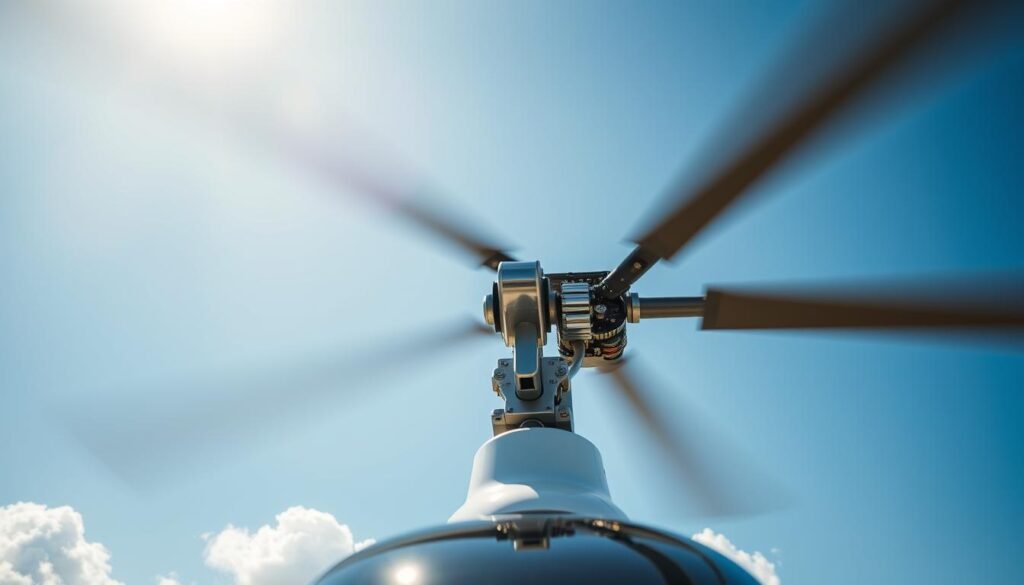Historic Helicopters began life in 2013 when Andrew Whitehouse set out to preserve, restore, and operate a select fleet of vintage military rotorcraft.
The group merges engineering rigor with public access. Members, a registered charity, and a dedicated shop support restoration, display, and education across the United States.
From assessment to flight demonstrations, the organization shows how Westland Whirlwind, Wessex, Sea King variants, Widgeon, and Lynx airframes are returned to airworthy status.
Visitors learn where to watch these rare machines fly, how to support work through donations or membership, and why keeping them operational matters for modern rotorcraft safety and design.

For a deeper look at key milestones that shaped rotary-wing innovation, see an overview of important breakthroughs in helicopter history.
Key Takeaways
- Founded in 2013 by Andrew Whitehouse to restore and operate vintage military rotorcraft.
- Combines technical restoration, safety testing, and public demonstrations.
- Operates as a membership organization, registered charity, and runs an official shop.
- Maintains flight-ready examples like Whirlwind, Wessex, Sea King, Widgeon, and Lynx.
- Supports education, events, and donor-driven preservation across the U.S.
Historic Helicopters: Preserving, Restoring, And Operating Vintage Military Icons
Historic Helicopters preserves, restores, and operates a select fleet that returns classic military rotorcraft to flight. The program began in 2013 and pairs careful documentation with engineering oversight.
Mission And Heritage: From Preservation To Flight
The mission tracks a clear path from static conservation to certified operations. Teams document condition, run tests, and verify airworthiness before any display flight.
End-To-End Service: Assessment, Restoration, And Operational Support
They provide a complete service: assessment, parts sourcing, structural work, avionics checks, engine runs, and crew training. Each step follows checklists and safety reviews to keep aircraft flight-ready.
Storage And Technical Storage Access For Necessary Legitimate Purpose
Controlled storage and technical storage protect airframes and records. Technical storage access is logged so every inspection and repair meets a necessary legitimate purpose.
User Preferences, Information Access, And Statistical Purposes
User preferences for communications are honored. Non-identifying information supports planning and statistical purposes that improve demonstrations and visitor safety.
How Past Innovations Inform Future Aviation
Legacy designs teach modern technologies and training. Documented storage access and access used exclusively for maintenance preserve traceability and support ongoing safety improvements.
Iconic Aircraft That Shaped Aviation’s Future
A curated roster of identified airframes reveals the design choices that shaped later flight safety.
The list below profiles named machines and explains why each matters for restoration, training, and operational learning.

Westland Whirlwind HAR10 XJ729
The Whirlwind brings early search-and-rescue practice to life. Its layout informs current crew workload standards.
Westland Wessex HU5 XT761
Wessex XT761 shows how transport configurations affected troop and cargo handling. Restoration teams preserve original fittings where safe.
Westland Wessex HU5 XT771
XT771 highlights avionics upgrades that later became common. Its history helps shape wiring and corrosion control work.
Westland Sea King HAR3 XZ597
Sea King HAR3 XZ597 demonstrates overwater rescue design. Lessons from its systems guide modern survivability checks.
Westland Sea King HC4 ZA314
HC4 ZA314 and ZF122 show amphibious and transport roles. They influenced deck handling and flotation planning.
Westland Sea King HC4 ZF122
ZF122 is a reference for load planning and crew procedures. Its records inform inspection intervals.
Westland Widgeon
The Widgeon adds a utility perspective. Small airframes teach compact systems integration.
Westland Sea King MK48 RS02
MK48 RS02 and RS04 reveal SAR avionics evolution. Their configurations shaped sensor placement and crew layout.
Westland Sea King MK48 RS04
RS04 continues the MK48 lineage with refinements that improved mission reliability.
Westland Sea King MK5 XV647
MK5 XV647 bridges service roles and equipment upgrades. It is a model for balancing authenticity with airworthiness.
Westland Sea King HAR3 XZ588
HAR3 XZ588 preserves rescue heritage and material choices. Documentation supports traceable maintenance.
Westland Lynx AH7 XZ616
The Lynx adds agility and performance lessons. Its profile helps modern pilots and engineers adapt training and technologies.
| Airframe | Role | Key Lesson |
|---|---|---|
| Whirlwind HAR10 XJ729 | Search & Rescue | Crew workload and hoist systems |
| Wessex HU5 XT761 / XT771 | Transport | Cargo handling and avionics upgrades |
| Sea King Variants | SAR / Amphibious | Overwater procedures and survivability |
| Widgeon | Utility | Compact systems integration |
| Lynx AH7 XZ616 | Agility / Patrol | High-performance handling and training |
Preservation Notes: Controlled storage protects parts and records. Selective technical storage access keeps provenance intact. Technical storage processes ensure each component is traceable.
Ground runs yield data used for statistical purposes. That data refines checks that meet the purpose of safe operation.
Public access gives each user clear lineage and mission notes. These records help teams restore aircraft while honoring original design intent.
See, Support, And Service The Legacy Across The United States
storage access begins the path from hangar to horizon. Discover where to watch restored aircraft in flight, sign up for membership, or visit the charity shop at events nationwide.
Events And Live Demonstrations: Where To See The Aircraft In Action
Scheduled flypasts and static displays list locations and viewing guidance. Each event includes safety briefings and clear access routes for attendees.
Membership, Donations, And The Charity Shop
A subscriber user can join tiered plans that include early notices, requested subscriber perks, and exclusive merchandise. Donations and corporate support fund parts, service work, and restoration priorities.
Hangar Updates: Restoration News Straight From The Team
Teams publish timely information about project milestones and test flights. Notes explain how storage access and access used zones are managed for safe tours and photo opportunities.

| Offer | Who Benefits | Key Advantage |
|---|---|---|
| Event Access | Subscriber User / Public | Live demos, safety briefings, viewing guidance |
| Membership Tiers | Requested Subscriber Groups | Early tickets, priority lines, members-only briefings |
| Hangar Updates | All Users | Restoration news, timelines, access procedures |
| Charity Shop | Supporters | Exclusive gear and fundraising revenue |
Marketing communications respect user preferences. Public notices also clarify when an external party handles logistics so attendees know who to contact on site.
Conclusion
storage stewardship keeps restored craft flight-ready while honoring provenance and safety.
Careful teams combine technical storage, rigorous checks, and technical storage access logs to document every part and repair under a necessary legitimate purpose.
Controlled protocols—like access used exclusively zones and storage access used procedures—protect authenticity and chain-of-custody. Insight from inspections guides maintenance for statistical purposes and improves planning.
Clear information helps a requested subscriber or subscriber user set preferences for updates. Proven technologies and targeted marketing support outreach without compromising purpose or security.
Visitors and donors take part through memberships, events, and gifts. That shared support keeps the collection alive for future learning and inspiration.
FAQ
What is the mission of the organization that preserves and operates vintage military aircraft?
The organization preserves, restores, and operates vintage military aircraft to educate the public and keep aviation heritage flying. It focuses on maintenance, operational safety, and authentic restoration while also providing flight demonstrations and static displays to inspire future engineers and pilots.
What services are offered for assessment, restoration, and operational support?
Services include condition assessments, parts sourcing, airframe and avionics restoration, ground testing, and flight certification. Trained technicians handle corrosion control, structural repairs, and modern avionics installs where necessary to meet airworthiness standards and regulatory requirements.
How is storage and technical storage access managed for aircraft and parts?
Aircraft, engines, and critical parts are stored in climate-controlled hangars with restricted technical storage access. Access is granted only for necessary legitimate purposes such as maintenance, inspections, or approved research. Inventory systems track parts and log access for accountability and safety.
Who can request access to stored technical information or components?
Access requests come from certified maintenance crews, restoration partners, regulatory inspectors, and approved researchers. Each request is evaluated to confirm it serves a legitimate purpose, and records of access are maintained for auditing and safety compliance.
How are user preferences and information used for communication and marketing?
Subscriber preferences collected during sign-up determine the type and frequency of communications, such as restoration updates, event notices, and fundraising appeals. Information is used for marketing and statistical purposes to improve outreach while honoring unsubscribe requests and privacy choices.
What measures protect personal data and subscriber information?
The organization implements industry-standard data protection practices, including encrypted storage, access controls, and procedures that restrict technical storage access to authorized staff. Personal data is used only for stated purposes like ticketing, memberships, and newsletters.
How does the team balance historical authenticity with modern safety requirements?
Technicians and aviation engineers evaluate each component to retain historical authenticity where safe, while integrating modern safety systems when necessary. Modifications follow regulatory guidance to ensure aircraft remain airworthy for demonstrations and ferry flights.
Which iconic aircraft are currently under care and often featured in displays?
The collection includes notable types such as the Westland Wessex HU5 and Westland Sea King variants, among others. These aircraft are maintained for flight or static exhibition, with restoration status updated regularly for members and visitors.
Where can the public see events, live demonstrations, or restoration open days?
Events are listed on the organization’s website and social channels, with schedules for airshows, hangar open days, and fundraising events across the United States. Registered subscribers receive priority access and event alerts based on their preferences.
How can someone support the preservation efforts through membership or donations?
Support options include memberships, one-time donations, sponsorship of restoration projects, and purchases at the charity shop. Membership benefits often include behind-the-scenes access, restoration briefings, and discounted tickets to events.
How are statistical purposes applied to improve operations and outreach?
Aggregated, anonymized data helps optimize visitor services, plan events, and prioritize restoration projects. Statistical analysis guides marketing strategies and resource allocation without exposing individual subscriber details.
What are the protocols for lending or borrowing parts between museums and repair facilities?
Loan agreements specify the legitimate purpose, duration, and conditions for handling parts. All transfers require documentation, proof of qualified handlers, and agreed procedures for storage, transport, and return to preserve provenance and safety.
Can researchers access technical archives or aircraft specifications for academic work?
Approved researchers may request access to technical archives for historical or engineering research. Requests are reviewed to ensure they serve a legitimate purpose, with usage restrictions and citation guidelines applied to protect sensitive information.
How often are hangar updates and restoration news shared with supporters?
Restoration milestones and hangar updates are published regularly through newsletters and social media. Frequency varies with project pace, but subscribers typically receive monthly updates and special alerts for major achievements.
What safety and compliance standards guide restoration and flight operations?
Restoration and flight operations follow Federal Aviation Administration rules and industry standards for maintenance, inspections, and pilot qualifications. Safety management systems and documented procedures ensure consistent compliance and risk mitigation.
Related Articles
- How Helicopters Revolutionized Emergency and Rescue Operations
- Helicopter Milestones: Important Breakthroughs in Aviation History
- Iconic Helicopters That Shaped the Future of Aviation
- The Role of Helicopters in World War II and Beyond
More from This Category
- Top 10 Helicopter Facts You Probably Didn’t Know
- Military Helicopters Through History: Key Models and Their Impact
- How Helicopters Work: The Science Behind Vertical Flight
- Who Invented the Helicopter? A Look at the Pioneers Behind Rotary Flight
- Helicopter Evolution: How Rotary-Wing Aircraft Changed Aviation Forever
- The Fascinating History of Helicopters: From Invention to Modern Aviation



